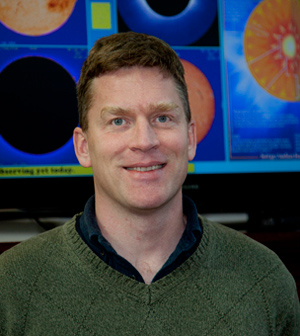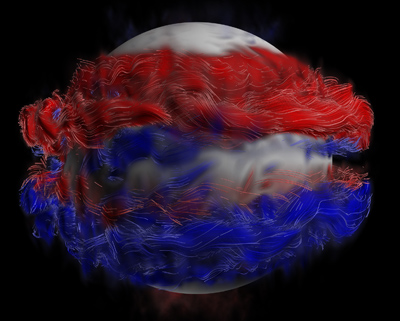Tying the Sun together
New models combine the Sun’s dynamo and magnetic flux
Feb 7, 2012 - by Staff
Feb 7, 2012 - by Staff
February 6, 2012 • When the Sun spits out plasma, it can mean a great deal to those of us on Earth. These magnetized ejections are the source of space weather, which brings us the beauty of the aurora and the risk of fouled-up telecommunications and electric grids. But what does the emergence of magnetic flux mean for the Sun?
A group of solar physicists at NCAR and elsewhere is trying to answer that question with a new generation of computer models. These simulations are looking at the solar dynamo—which is responsible for generating magnetic flux and establishing the Sun’s 22-year magnetic cycle—as well as the emergence of magnetic flux out of the solar interior and into the solar atmosphere, where it produces sunspots and powers space weather. The key to both of these processes is solar convection—the turbulent, churning motions that occupy the outer third of the solar interior and that establish large-scale flows that help amplify and organize magnetic flux.

Mark Miesch and colleagues are working on new models that simulate the solar dynamo as well as the emergence of magnetic flux from the solar interior. (Photo by Carlye Calvin.)
Modeling convective dynamos and flux emergence alone are two challenging tasks. The attempt to portray both in a single simulation goes a step further, one that pushes the edge of physicists’ knowledge as well as the limits of their computing power. But, they say, it’s a necessary step to figure out whether flux emergence is merely a by-product of the solar cycle or actually a key factor that drives it.
“When you look at other stars, there’s a clear connection between convection and magnetism,” says Mark Miesch (NCAR High Altitude Observatory). Only some stars show magnetic activity, he notes, but those are the very stars that also feature convection near the surface. Yet it’s unclear how the scattered irregularity of the Sun’s small-scale, largely north-south aligned convective motions produce the more organized, east-west, cyclic magnetic flux that is the hallmark of the solar dynamo and flux emergence.
“How does a turbulent flow create an organized field?,” asks Miesch. “That’s one of the guiding themes of my research—how do you create order out of chaos?”
Models are critical to answering this question, because solar physicists can’t yet peer deep into the Sun to track its magnetic innards. Acoustic waves deep within the Sun can be sensed and analyzed, a practice called helioseismology, but that doesn’t yield direct data on magnetism. Other observational clues have come from the surface magnetism tracked by Earth- and space-based instruments, including several developed by NCAR’s Bruce Lites and colleagues.
One important insight from those observations is that when sunspots emerge in pairs, as they generally do, their vertical magnetic fields are oriented in opposite directions (a process modeled several years ago in striking detail by NCAR’s Matthias Rempel and colleagues).
That’s where flux tubes come in. If such a tube were to rise to the Sun’s surface, with its center arching as it rose—a byproduct of buoyancy—then the two trailing ends of the tube would create sunspots after the tube entered the Sun’s atmosphere. The process by which this magnetic loop redistributes itself after emergence and thus produces north-south flux, the Babcock-Leighton mechanism (BL), is a 50-year-old concept that’s well accepted but poorly modeled to date. The new modeling by Miesch and colleagues may help answer the question of whether the BL mechanism is indeed a critical factor in the Sun’s magnetic cycle.
“It’s a complex, unresolved issue,” says Miesch.
Because it’s such a computationally demanding task to simulate convective dynamos and flux emergence, most solar dynamo models to date have approximated convection and the BL process rather than depicting them directly. That’s the case with the groundbreaking solar dynamo model produced by NCAR’s Mausumi Dikpati and Peter Gilman, which was the first one to provide physics-based forecasting of future solar activity.
Several such models now generate realistic solar cycles, so it’s possible that the details of transient convection aren’t critical to the magnetic cycles. To get a better sense, Miesch and colleagues at several other institutions are drawing on NASA grants and NSF support and taking the next steps.

New simulations of a star much like the Sun, but rotating five times faster, produce wreaths of magnetism in each hemisphere. The blue and red areas denote magnetic flux oriented toward the east and west, respectively. Faint lines trace the local direction of the three-dimensional magnetic field. (Simulation by Brown, Miesch et al.; visualization by Tim Sandstrom and Chris Henze, NASA.)
The group’s first effort was to simulate a star similar to the Sun but rotating three times faster, an adjustment that helped accentuate the physical processes responsible for generating organized magnetic fields from the turbulent convection.
What emerged were long-lived magnetic “wreaths” completely circling the star in each hemisphere (see graphic), an encouraging sign.
Next, they increased the rotation rate further, to five times that of the Sun. This time the wreaths waxed and waned cyclically, showing repeated polarity reversals similar to those seen in the actual Sun. Led by Benjamin Brown (University of Wisconsin–Madison), these studies appeared in The Astrophysical Journal in 2010 and 2011.
Nicholas Nelson (University of Colorado Boulder) then led the team’s charge to bring flux emergence into the picture. The researchers carried out the first-ever three-dimensional simulation of an entire star with a dynamo that can generate buoyant magnetic flux tubes on its own.This work, published in Astrophysical Journal Letters in October, is a major step forward, says Miesch. He and Brown were coauthors, along with former CU postdoctoral researcher Allan Sacha Brun (now at France’s National Center for Scientific Research) and CU’s Juri Toomre.
The results get even more complex—in a promising way—in a paper by Miesch and Brown soon to be published in The Astrophysical Journal. In this case, the modelers included a term that mimicked the BL process, thus bridging the gap between convective dynamo simulations and the mean-field models of Dikpati and Gilman.
The change meant that, for the first time, this deep convective dynamo (again on a star spinning three times faster than the Sun) could “sense” the influence of surface flux emergence. These results bear even closer resemblance to the real Sun: the wreaths migrate toward the equator and reverse polarity, much as sunspots do.
While it’s still not clear if the BL process is required in order to produce the solar cycle, these results confirm that flux emergence can help promote organized behavior in an otherwise chaotic dynamo.
“These simulations are pulling together the pieces of the stellar dynamo puzzle,” says Brown, adding that the simulations are a testing ground for ideas like the BL process, which scientists then extend to the stars. “As we test these ideas, we’re getting a better handle on how our Sun might build its own magnetic fields.”
According to HAO director Michael Thompson, “Understanding the Sun’s magnetic dynamo and flux emergence remains a grand-challenge problem in solar physics. These modeling efforts are at the forefront of our attempts to understand these processes. The computing power of the new NCAR-Wyoming Supercomputer Center (NWSC) is going to be a big help in the quest.”